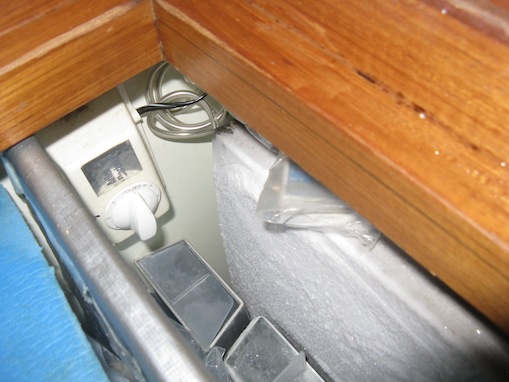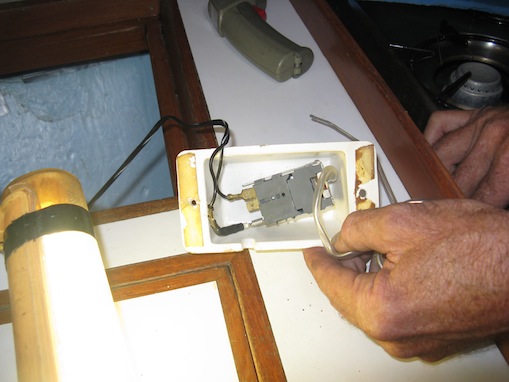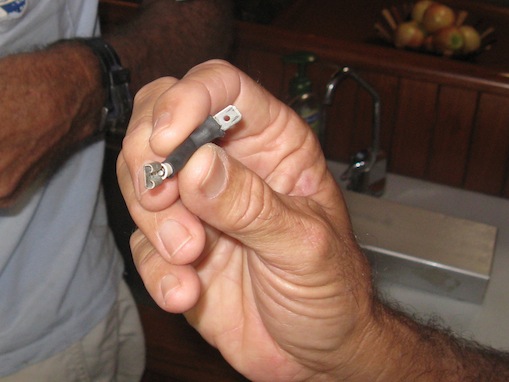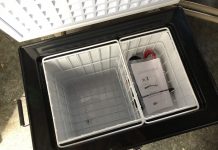Imagine discovering a way to cut daily amp consumption in HALF! Like most boats, our refrigeration takes well more than half the amps we need in any given day. We were used to using 6 amps an hour every hour the compressor condenser was running, which was about half the time or 72 amps a day. Right now, as I write this, it’s drawing 3 amps an hour and running half the time … that’s only 36 amps a day. And it’s not the insulation. Of course, it’s only been a few hours, so the verdict remains out, but here’s the story —
Last week it abruptly quit and we called a service company, Blue Ice Marine, in Punta Gorda, Florida (for those boats that might be near by looking for a good marine refrigeration company). But when David installed our new starter battery, the fridge fired right up and has been working since.

All these years we’ve wished for a “real” refrigerator on the other side where the ice box was originally on our 1985 vintage boat. David drilled holes in the wall allowing the cold air to seep over from the freezer side and I can use it as a cooler, but not really a refrigerator. (more on this in another post very soon).
We had Blue Ice David (call him at 941-626-8040 if you’re near Punta Gorda, FL) come out to consult about the amp consumption and if there was anything we could do inexpensively to make the other side a “real” refrigerator. We’re glad we did becaus, even though we’ve had the boat almost 15 years, we learned all sorts of important new facts today:
1. The ColdPlate we have, unlike the Adler Barbour ColdMachine, runs for hours and then shuts off for hours – all along we thought it wasn’t cycling, but it was, and is, functioning exactly right.
2. He checked the ColdPlate with a special sensor that told him it was too warm… at this point I’m thinking — “oh crap, a new ColdPlate is big money — I think last time I looked, over a thousand dollars”. 🙁 But then he climbed into the lazarette in the cockpit to check the compressor condenser.

3. The condenser unit we installed two years ago had too much refrigerant, causing frost to form too far along the lines from the condenser to the ColdPlate. So Blue Ice David bled off some of the excess refrigerant. Sure enough the ColdPlate almost immediately dropped from 26 degrees to 21 degrees, and later fell to 15. WooHoo, who would have thought bleeding off a little excess refrigerant would save us over a grand in not having to replace a ColdPlate that was running too warm!
4. Blue Ice David was also concerned about our 6 amp an hour comment – said it shouldn’t draw more than 2 1/2 – 3 amps/hour. Nope, it’s always drawn 6 amps whenever the condenser is running.
Then came the biggest shock — would we like it to draw 3 amps an hour instead of 6 amps? Mr Amp Ogre (that would be my David) LIT up. Of course, but what would need to happen and how much would it cost?

Surprisingly enough, he said there’s a speed resistor located either close to the condenser or by the thermostat – ours happened to be on the thermostat because it’s the original thermostat from 1998. He explained that the speed resistor tells the condenser to run at full speed or slower — his analogy was a cadillac and a vw bug will both get you to the mall, and both will get you there in the same amount of time, but one is a V8 and one’s a V4, the V4 uses smaller amounts of energy.
In the refrigerator’s case, the speed resistor was telling the condenser to run V8 anytime it was on. Taking the speed resistor out, immediately caused our amp consumption to drop in half — we watched as he removed the resistor and the amp meter dropped from 6 to 3.

So me, being the “if it’s too good to be true” sort, asked what the downside is … apparently initially without the speed resistor, it will take longer for the ColdPlate to get down to temperature and freeze/cool, but once it’s down to temperature, it will freeze and cool exactly the same, except we’ll be using 3 amps an hour when it’s on versus 6 amps.
So we just CUT THE BOAT’S BIGGEST AMP DRAW IN HALF! Maybe we don’t need another 200 watts of solar panels after all!
The saddest part is, in 15 years no one else has ever mentioned this minor possibility? We didn’t know to ask the question, we always assumed it should run at 6 amps/hour. I looked in the manual & couldn’t find any mention of it either.
Time will tell if it continues to keep everything chilled and frozen. Blue Ice Dave left a sensor on top of the ColdPlate which will automatically read it every minute for a day & a half. When we return it, he’ll plug it into his computer & it will tell him exactly when the condenser was running and the temperatures on the ColdPlate – just to make sure removing the speed resistor didn’t screw anything else up… Can you tell I’m impressed?
SO, if you have an Adler Barbour refrigeration system, it might be worth a call to AB tech support to find out about the speed resistor – as I said, ours was connected to our thermostat, but Blue Ice David said the newer models often have them close to the condenser unit.
Plus he made another recommendation which we’ll share when we accomplish the next project! Things are looking much chillier aboard Winterlude!
Happy refrigerating! Any other experiences? Please leave a comment and share! Cheers! Jan














Excellent information … except for that “V”-4 Volkswagen comment. 🙂 Thanks for the daily dose of nautical wisdom.
Hi Rich! Actually that VW Bug is one of my dream cars — someday. But now that they’ve changed the body style, I may have to find a “vintage” model. 🙂 Cheers! Jan
My amp meter says 3/5 amps being drawn when my Adler-Barber refer unit is the only thing cycling. Does that mean it’s okay per your article? I installed this new Adler-Barber system myself 1 1/2 years ago. It doesn’t frost up the evaporator unit as fast as the old one did.
Is this good?
Cecile
Correction: 3.5 amps, not 3/5 amps.
YES! Mine is drawing a bit over 3 amps, but we’re having trouble with it frosting up quicker than before. Troubleshooting means the new door seals we just installed aren’t doing the job and there’s outside moist air getting in. 🙁 We’re on a search to find something better to use on the door seals. Cheers! Jan
Hmm… Jan, I’ll be looking forward to your follow-up on the speed resistor story. Since it’s now drawing half the power, I would assume (knowing nothing more) that it should take nearly twice as long for the cold plate to reach operating temp – but you also corrected the excess coolant issue at the same time, so it’s going to be interesting to see the final result.
Keep us posted!
Will do! We’re looking forward to seeing the sensor report. You are correct in thinking it will take longer upon initial startup to reach the coldplate temperature. But that only happens once a year for us, then it’s on for the next six months. It’s also interesting that the we’re having a bit of difficulty getting the thermostat adjusted. When the tech left, he had it set on 5. By noon the next day it was freezing everything on the refrigerator side, so I turned it down to 2. Six hour later the frost on the top of the plate was thawing so David turned it to 3. A day later it’s still good. But long term remains to be seen, it’s not hot here in FL, but will be back to 86 later this week.
I hate to be a stickler, but… (No, actually, I don’t. I think it’s important to get things right.)
“Amps” is a measure of electron flow, not a measure of electrons. The phrase “amps/hour” indicates a change in the current flow — if I have a device that draws 3 amps when I first turn it on, but over the course of 10 hours gradually begins to draw 13 amps, I would say that the current is changing at the rate of 1 amp/hour. Your refrigerator used to draw 6 amps and now draws 3, not 6 amps/hour and 3 amps/hour. At three amps, if the compressor actually runs for 4 hours a day, it has consumed 12 amp-hours, which is a measurement of the number of electrons that have passed through it.
Technically, an Ampere is a current (flow) of one Coulomb/second, where a Coulomb is a very specific (and very large!) number of electrons. One amp-hour is thus equivalent to 3,600 Coulombs.
Hi Jim — I’m definitely not an expert on amp usage aboard. I do know that if I use 6 amps for 12 hours (i.e. 6 amps/hour in my simple mind) I use 72 amps for the day. If I use 3 amps for 12 hours (3 amps/hour) it’s only 36 amps for the day. So far the numbers are holding true, but we’re waiting on our windlass to come back to try it out at anchor for a week. I’m sure you’re right, I just don’t have the technical background to understand it. 🙂 Cheers! Jan
Why not wire the speed resistor back in with a switch so you can have a V8 when you need/want it. When you start it up and want to initially cool it down, or when you load it up with lots of warm stuff.
Good idea! David’s wearing his plumber hat today — when we were reinsulating the fridge, and shopping at Lowe’s, we found a new head faucet that’s not green, plus it’s supposedly “stainless” so maybe it’ll resist turning green. 🙂 I’ll mention the speed resistor with a switch idea to him after the plumbing project is complete. In the meantime, I’d doing laundry. Cheers! Jan
Just returned from our first Winter stay at Fishermans Village,Punta Gorda. AdlerBarbour Cold Machine falling apart due to rusting fan and base. I’m worn out from ice runs. Good news we have very good insulation of the cooling compartment. Fellow sailors running out purchasing drop in Engel units to cut amp draw. Wish I had seen this earlier. Need to determine best approach to refrig renovation/replacement before next Fall.